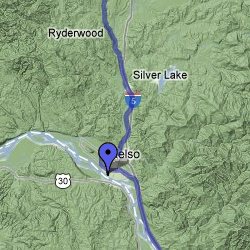Category: News
Cedarville Rancheria Shooter Killed Brother, Niece, Nephew: Police
Police are still processing what they called a horrific crime scene at Cedarville Rancheria tribal headquarters near Altura, California, after 44-year-old Sherie Rhoades gunned down her brother, niece and nephew at an eviction hearing.
Four people in all were killed, including the tribal leader, Rhoades’s brother, the Associated Press Reported. Two were critically wounded.
Altura police identified the deceased as Angel Moonstar Penn, 19; Glenn Phillip Calonico, 30; Shelia Lynn Russo, 47, and Rurik Daniel Davis, 50. Russo was not related to Rhoades, AP said.
The two wounded survivors were sisters, the Los Angeles Times reported, and they were flown to hospitals in Redding, about 130 miles away. Altura police said in an e-mailed statement that “as of this morning, one victim was still listed in critical condition and the second was alert and talking.”
Rhoades was taken into custody.
“There are no public safety concerns and we have no information indicating there was any other suspects involved at this time,” the police statement said. “Rhoades was being held at the Modoc County Jail on charges of homicide, attempted murder, child endangerment and brandishing a weapon. She has been moved to an undisclosed facility, for her safety.”
Nearby Alturas Indian Rancheria closed their tribal headquarters on Friday out of respect after the Thursday February 20 shooting.
The carnage began at about 3:30 p.m., according to police and witness accounts, when former tribal chairwoman Sherie Lash, also known as Sherie Rhoades, pulled out a 9-millimeter shotgun during a hearing about the potential eviction of her and her son from tribal lands.
A judge who had been remotely attending the hearing via phone could only listen, KTXL-TV reported.
A witness escaped from the offices and ran down the street, covered in blood, to summon police, KRCR-TV reported. When officers arrived they found the 44-year-old Rhoades outside the building, clutching the butcher knife she had grabbed from the kitchen when she ran out of ammunition.
Police said the investigation is ongoing and that the investigators from the California Department of Justice and the California Highway Patrol Multi-Disciplinary Accident Investigation Team are helping local police process the crime scene. The victims were scheduled to be autopsied on Friday, according to News-10.
“We’re trying to get this thing resolved as quick as possible,” Alturas Police Chief Ken Barnes told News10-TV. “So it’s, it’s a huge impact on our community.”
Read more at http://indiancountrytodaymedianetwork.com/2014/02/21/cedarville-rancheria-shooter-killed-brother-niece-nephew-police-153686
For Abused Native American Women, New Law Provides A ‘Ray Of Hope’
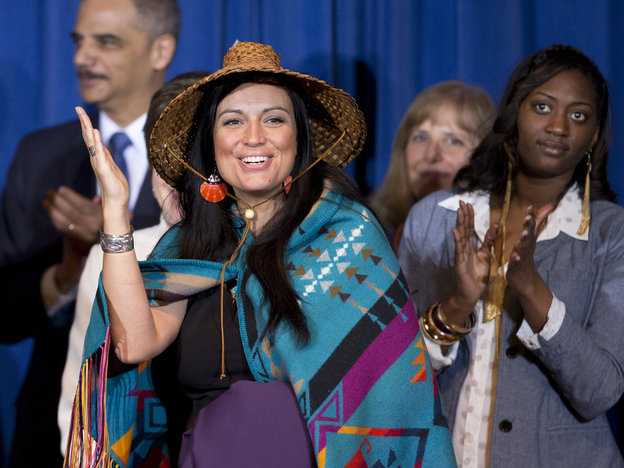
Manuel Balce Ceneta/AP
By Hansi Lo Wang, from NPR All Things Considered show
This Thursday, three Native American tribes are changing how they administer justice.
For almost four decades, a U.S. Supreme Court ruling has barred tribes from prosecuting non-American Indian defendants. But as part of last year’s re-authorization of the Violence Against Women Act, a new program now allows tribes to try some non-Indian defendants in domestic abuse cases.
It will be another year before the program expands to other eligible federally-recognized tribes around the country in March 2015. But the Department of Justice has selected three tribes to exercise this authority first, including the Pascua Yaqui Tribe of Arizona, the Confederated Tribes of the Umatilla Indian Reservation in Oregon, and the Tulalip Tribes, located north of Seattle.
‘Going To War’
Deborah Parker serves as the Tulalip Tribes’ vice chair. For three years, she flew back and forth between Washington state and Washington, D.C., giving speeches and knocking on doors — an experience that she says felt like “going to war.”
“You got to go to battle,” Parker says, “and you have to convince a lot of people that native women are worth protecting,”
And that protection, Parker was convinced, had to come from Congress. So she pushed for legislation allowing American Indian tribes to prosecute non-Indian defendants in domestic violence cases.
About four out of every ten women of American Indian or Alaskan Native descent have “experienced rape, physical violence or stalking by an intimate partner,” according to the Centers for Disease Control and Prevention. It’s an alarming statistic that Parker knows all too well from growing up on the reservation.
“We didn’t have a strong police presence when I was younger. Even [if you called] the police, often they didn’t respond,” she says. “When they did, they would say, ‘Oh, it’s not our jurisdiction, sorry.’ [And] prosecutors wouldn’t show up.”
A Question Of Jurisdiction
Jurisdiction is the key word in this discussion.
In 1978, the Supreme Court ruled in Oliphant v. Suquamish Indian Tribe that tribal governments have no jurisdiction over crimes committed by non-Native Americans on tribal land.
Instead, tribes have to rely on federal prosecutors to take on such cases, and prosecutors have not always been able or willing to consistently pursue reports of domestic violence.
Deborah Parker and other advocates pushed to address this issue — and some lawmakers in Congress pushed back.
One of the most vocal opponents of the new program was Republican Sen. Charles Grassley of Iowa. He voiced his concerns about the constitutionality of the program during a Senate debate last February, weeks before the Violence Against Women Act was reauthorized.
“The key stumbling block to enacting a bill at this time is the provision concerning Indian tribal courts,” Grassley said, referring to a provision that allows American Indian tribal courts to have jurisdiction over non-Indians accused of domestic violence.
Stepping Towards A Solution
But Fred Urbina, chief prosecutor for the Pascua Yaqui Tribe, says the provision that passed is fairly complicated and narrow. “This basically helped it pass through Congress and get approval, so everybody’s describing this as a first step,” he says.
The “special domestic violence criminal jurisdiction” program is limited to certain domestic violence cases involving non-Native American defendants who are in existing relationships with Native Americans and living or working on the reservation. In Alaska, it only applies to the Metlakatla Indian Community of Annette Islands Reserve.
Still, the Pascua Yaqui Tribe’s Attorney General Amanda Sampson Lomayesva says the program will offer a new route for justice.
“It is a ray of hope,” she says “Maybe we can start protecting people and having the tribal members who live here on the reservation feel like something will be done.”
Brent Leonhard, an attorney for the Confederated Tribes of the Umatilla Indian Reservation, also sees the program as a partial solution to “a mess created both by a Supreme Court decision and by federal law and policy.”
“This is a step towards trying to improve that,” he says.
Parker acknowledges that the program “doesn’t answer all the questions” about how tribal governments can play a more direct role in addressing crime by non-Native Americans.
“But it allows us to exert jurisdiction and arrest those who violate protection orders [and commit] dating violence [or] domestic violence,” says Parker, who adds that she hopes the program will give a stronger voice to more Native American women
Shooting at Cedarville Rancheria Tribal Office Leaves 4 Dead, 2 Critically Injured

KRCR-TV
Scene of the fatal shooting of four people at the Cedarville Rancheria Tribal Office and Community Center outside Altura, California on February 20.
Read more at http://indiancountrytodaymedianetwork.com/2014/02/21/shooting-cedarville-rancheria-tribal-office-leaves-4-dead-2-critically-injured-153670
Four people are dead, two are critically injured and a woman is in custody after a shooting at the Cedarville Rancheria Tribal Office and Community Center in Alturas, California.
Police say the 44-year-old woman, known as Sherie Lash, or as Sherie Rhoades, opened fire during an eviction hearing at about 3:30 p.m. Pacific time on February 20, Reuters reported. Two women, aged 19 and 45, and two men, 30 and 50, died, and two others were airlifted to hospitals in critical condition. Police told ABC affiliate KRCR-TV that one of the deceased was the current tribal leader.
Rhoades, a former chairwoman of the 35-member federally recognized tribe, was attending a hearing about her potential eviction from tribal lands, the Redding, California, Record Searchlight reported. After shooting the five people, Rhoades allegedly went after a sixth with a butcher knife, police said.
Cedarville is about 15 miles east of Alturas, in northeastern California near the Oregon border.
Check back for updates from ICTMN.
Read more at http://indiancountrytodaymedianetwork.com/2014/02/21/shooting-cedarville-rancheria-tribal-office-leaves-4-dead-2-critically-injured-153670
17 more bison shipped to slaughter
Billings Gazette Feb 19, 2014 • By Brett French
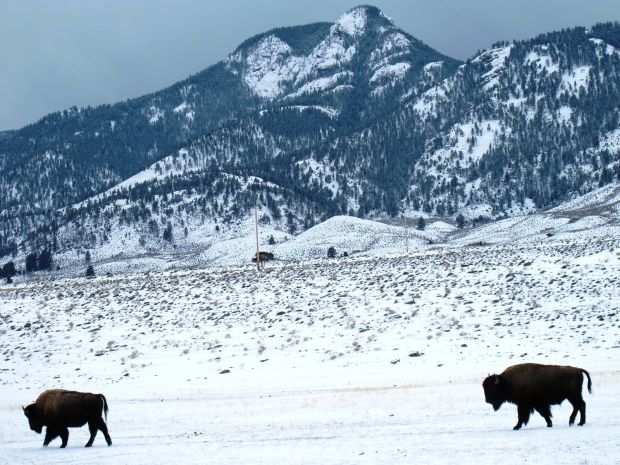
Bison wander back toward Yellowstone National Park from outside the park’s northern border in the Gardiner Basin recently. The park continues to ship bison to slaughter to reduce the number of animals in the park.
The Confederated Salish and Kootenai Tribes trucked 17 more Yellowstone National Park bison from the park’s Stephens Creek bison capture facility to a slaughter facility in Ronan on Wednesday.
The tribes pay a game warden to ride along with the shipment of animals to shoot them if there is an accident and the bison escape from the trailer, a requirement of the Montana Department of Livestock.
That requirement was unknown to the Inter Tribal Buffalo Council, which had agreed to take any bison not wanted by Yellowstone treaty tribes. Initially, the DOL offered to provide one of its employees to ride along at a cost of $350 a trip. When the council balked at the cost, Yellowstone on Wednesday agreed to pay, said Christian Mackay, executive officer for the DOL.
“It’s not an insurmountable problem by any means,” Mackay said. “We have some loads scheduled this week to go out.”
Jim Stone, executive director of the buffalo council, said such “annoying” issues are roadblocks to fulfilling agreements under the Interagency Bison Management Plan and he called into question the DOL’s role in the process.
To date, tribal and state hunters have killed 162 bison, said Tom McDonald of the confederated tribes’ natural resources office. The Nez Perce, Shoshone-Bannock and Umatilla tribes are still conducting hunts. Montana-licensed hunters took 29 bison this season.
Last week, the confederated tribes transported another 20 bison from Yellowstone to slaughter and five were transferred to the USDA Animal and Plant Health Inspection Service for research. According to a Park Service spokesman, about 70 to 75 bison are now in the Stephens Creek corral. The bison were not hazed into the facility. Another 50 to 70 bison have moved past the park’s northern boundary in the Gardiner Basin while about 400 have gathered in the park roughly between the towns of Gardiner and Mammoth Hot Springs, Wyo.
Yellowstone officials want to remove 300 to 600 bison in consecutive years to reduce the size of the park’s herds to meet the terms of an agreement with the state of Montana. Bison advocacy groups have decried the move, saying a target population of 3,000 to 3,500 bison in the park is not based on the carrying capacity of the range. This summer the park’s bison herd was estimated at 4,600 animals.
Bison advocates would like to see the animals given more room to roam outside Yellowstone and a quarantine process enacted to transfer live animals to existing tribal bison herds. Those efforts have been fought by the livestock industry since many of the bison carry brucellosis, which can cause pregnant cattle to abort.
Defenders of Wildlife said 56,000 people had emailed Gov. Steve Bullock asking him to intervene and halt the slaughter.
McDonald said confederated tribes are taking bison to slaughter for hunters who were unsuccessful in filling their bison hunting tags. The hunters pay for the cost of shipping, slaughtering and butchering of the bison.
“When it’s all said and done, people love bison meat and are willing to pay a premium,” McDonald said. “Ninety-seven percent of the people who return to eating bison find it exceptional.”
He added that the hunts have been “self-esteem builders” for the parties of hunters that travel to Yellowstone’s borders.
“It’s almost a healing kind of thing,” McDonald said.
Quinault Denounces State Fish and Wildlife Commission Process
Water 4fish
TAHOLAH, WA (2/18/14)— “I am extremely disappointed that the State Fish and Wildlife Commission has chosen to unilaterally develop a management policy for Grays Harbor salmon,” said Fawn Sharp, President of the Quinault Indian Nation. Her comment referred to a recent news release in which the Commission announced its February 8 approval of a new salmon-management policy to conserve wild salmon runs and clarify catch guidelines for sport and commercial fisheries in the bay.
Amid Toxic Waste, a Navajo Village Could Lose Its Land
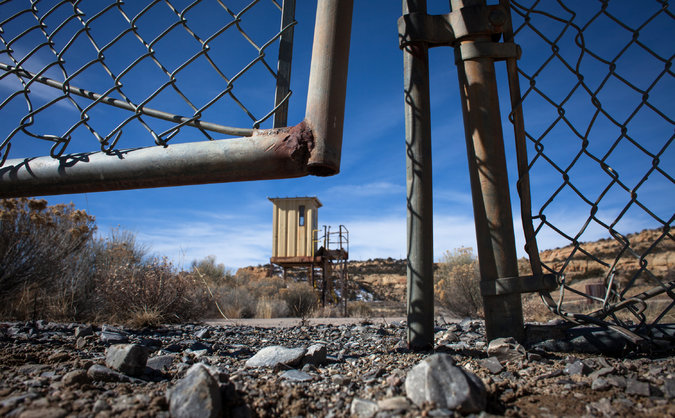
CHURCH ROCK, N.M. — In this dusty corner of the Navajo reservation, where seven generations of families have been raised among the arroyos and mesas, Bertha Nez is facing the prospect of having to leave her land forever.
The uranium pollution is so bad that it is unsafe for people to live here long term, environmental officials say. Although the uranium mines that once pocked the hillsides were shut down decades ago, mounds of toxic waste are still piled atop the dirt, raising concerns about radioactive dust and runoff.
And as cleanup efforts continue, Ms. Nez and dozens of other residents of the Red Water Pond Road community, who have already had to leave their homes at least twice since 2007 because of the contamination, are now facing a more permanent relocation. Although their village represents only a small sliver of the larger Navajo nation, home to nearly 300,000 people, they are bearing the brunt of the environmental problems.
“It feels like we are being pushed around,” said Ms. Nez, 67, a retired health care worker, who recalled the weeks and months spent in motel rooms in nearby Gallup as crews hauled away radioactive soil from the community’s backyards and roadsides.
“This is where we’re used to being, traditionally, culturally” she said. “Nobody told us it was unsafe. Nobody warned us we would be living all this time with this risk.”
These days, this sprawling reservation, about the size of West Virginia, is considered one of the largest uranium-contaminated areas in United States history, according to officials at the Environmental Protection Agency. The agency has been in the throes of an expansive effort to remove waste from around this tiny and remote Navajo village, and clean up more than 500 abandoned mine areas that dot the reservation.
Federal officials say they have been amazed at the extent of the uranium contamination on the reservation, a vestige of a burst of mining activity here during the Cold War. In every pocket of Navajo country, tribal members have reported finding mines that the agency did not know existed. In some cases, the mines were discovered only after people fell down old shafts.
“It is shocking — it’s all over the reservation,” said Jared Blumenfeld, the E.P.A.’s regional administrator for the Pacific Southwest. “I think everyone, even the Navajos themselves, have been shocked about the number of mines that were both active and abandoned.”
Between 2008 and 2012, federal agencies spent $100 million on the cleanup, according to the E.P.A.; an additional $17 million has been spent by energy companies determined to be responsible for some of the waste.
But the scope of the problem is worse than anyone had thought. The E.P.A. has said that it could take at least eight years to dispose of a huge pile of uranium mine waste that has sat near Red Water Pond Road since the 1980s — waste that must be removed before the area can finally be free of contamination.
“The community is frustrated, I know I’m frustrated — we’d like it to go quickly,” Mr. Blumenfeld said.
But before the latest round of cleanup can begin, an application to remove the waste pile must be submitted to the Nuclear Regulatory Commission, which will then conduct environmental and safety reviews. That process will probably take two years, and there is the possibility that public hearings on the plan could extend the process several more years, said Drew Persinko, a deputy director for the commission.
That time frame seems unreasonably long for tribal members, who said that spending so long living away from the reservation has been difficult. So far, the E.P.A. has spent $1 million on temporary housing for residents of Red Water Pond Road; much of that cost will be reimbursed by General Electric, which acquired the old Northeast Church Rock Mine site in 1997, and also its subsidiary company, United Nuclear Corporation, which operated the mine.
As in the past, the relocations will be voluntary. Some residents wondered — as they have for years now — if the land will ever really be clean.
“Our umbilical cords are buried here, our children’s umbilical cords are buried here. It’s like a homing device,” said Tony Hood, 64, who once worked in the mines and is now a Navajo interpreter for the Indian Medical Center in Gallup. “This is our connection to Mother Earth. We were born here. We will come back here eventually.”
Residents still remember seeing livestock drinking from mine runoff, men using mine materials to build their homes and Navajo children playing in contaminated water that ran through the arroyo. Today, the site near Red Water Pond Road holds one million cubic yards of waste from the Northeast Church Rock Mine, making it the largest and most daunting area of contamination on the reservation.
The waste does not pose any immediate health risk, Mr. Blumenfeld said, but there are concerns about radioactive dust being carried by the wind, runoff from rain, and the area’s accessibility to children, who can slip in easily through a fence.
Under a plan being developed by General Electric and the E.P.A., the waste would be transported to a former uranium mill just off the reservation — already considered a Superfund site — and stored in a fortified repository. The estimated cost is nearly $45 million.
“General Electric and United Nuclear Corporation are committed to continue to work cooperatively with the U.S. government, Navajo Nation, state of New Mexico and local residents to carry out interim cleanups and reach agreement on the remedy for the mine,” said Megan Parker, a spokeswoman for General Electric.
The Navajo E.P.A., which is an arm of the tribe’s own government, for years has been calling for a widespread cleanup of abandoned mines. Stephen Etsitty, the executive director of the agency, said he was hopeful that progress was finally being made, but acknowledged that the scope and technical complexity of the operation at Red Water Pond Road was unprecedented.
“We’re pushing and doing as much as we can to keep the process going as fast as we can,” Mr. Etsitty said. “It’s just taken so long to get there.”
On a recent day, Ms. Nez and several other residents stood on a bluff near a cluster of small homes and traditional Navajo hogan dwellings as the wind whipped across a valley that once bustled with mining activity.
The group talked of their grandparents — medicine men who were alive when the mines first opened — and wondered what they would think about Red Water Pond Road today.
“They would say ‘How did this happen? They ruined our land,’ ” Ms. Nez said. “ ‘How come you haven’t prayed to have this all fixed up?’ ”
A version of this article appears in print on February 20, 2014, on page A10 of the New York edition with the headline: Nestled Amid Toxic Waste, a Navajo Village Faces Losing Its Land Forever. Order Reprints|Today’s Paper|Subscribe
Tribal objects shown reverence on trip home to US
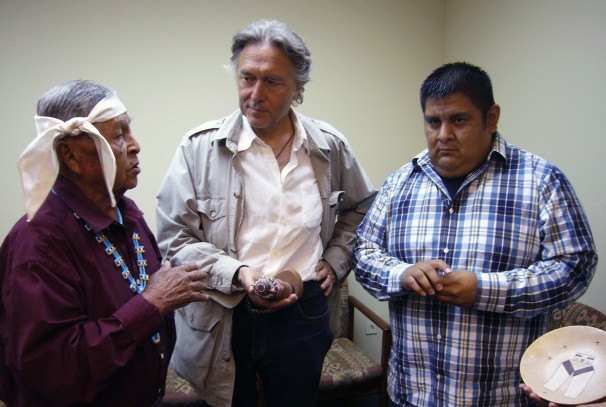
By Associated Press, Thursday, February 20, 2014
FLAGSTAFF, Ariz. — Two dozen ceremonial items bought last year at auction in France are set to return to Arizona in a way that pays reverence to the beliefs of American Indian tribes.
The masks and hoods invoke the ancestral spirits of the Hopi and Apache Tribes — who consider them living beings in keeping with tradition — and the expectation is they will be treated as such. That means shipping the sacred items free of plastics, bubble wrap or other synthetic material that would be suffocating. The items also should face the direction of the rising sun, have space to breathe, and be spoken to during their journey.
The shipping reflects the deeply sensitive nature of the items that the Los Angeles-based Annenberg Foundation quietly bought for $530,000 at a contested Paris auction two months ago with the goal of sending them back to their tribal homes in eastern Arizona.
The Hopi and two Apache tribes believe the return of the objects, kept largely out of public view, will put tribal members on a healing path and help restore harmony not only in their communities but among humanity.
“The elders have told us the reason we have the ills of society, suicides, murders, domestic violence, all these things, is we’re suffering because these things are gone and the harmony is gone,” said Vincent Randall, cultural director for the Yavapai-Apache Nation.
The tribes say the items — 21 pieces are headed to the Hopi, two to the San Carlos Apache and one to the White Mountain Apache — were taken from their reservations in the late 19th and 20th centuries at a time when collectors and museums competed for sensitive items from Western tribes. Tribal archaeologists say the objects also could have been traded for food and water, or unrightfully sold.
In Hopi belief, the Kachina friends emerge from the earth and sky to connect people to the spiritual world and to their ancestors. Caretakers, who mostly are men, nurture the masks as if they are the living dead. Visitors to the Hopi reservation won’t see the masks displayed on shelves or in museums, and the ritual associated with them is a lifelong learning process.
The San Carlos Apache recount a story of ceremonial items being wrenched from the hands of tribal members who were imprisoned by the U.S. military at Fort Apache. Journal entries from the time showed that hoods, as well as medicine bundles and other prayer items akin to crosses and holy water were taken, said Vernelda Grant, director of the Historic Preservation and Archaeology Department for the San Carlos Apache Tribe.
“Of course you’re going to be emotional, and of course it’s going to have an effect on your health, the welfare of your people,” she said. “It kills them, it killed us emotionally. Those items were taken care of until those times came. We were forced to hand them over so we could get what? A box of rations, a blanket?”
For the San Carlos Apache, the hoods represent the mountain spirits reincarnated in men who make and wear them in ceremonial dances for healing or when girls reach puberty. Each is fashioned by a tribal member endowed with a gift of being a spiritual leader. Once the hoods have been used, they are put away in an undisclosed location in the mountains, known only to the spiritual leader through a revelation from the “ruler of life,” or God.
If they are disturbed or removed, a curse of sorts can be placed upon humanity, Randall said.
Although the Apaches are among the most successful tribes in getting items within the United States returned to the tribes, they could do little to stop the sale in France.
The auction house argued that the items rightfully were in private collectors’ hands. A judge hearing the Hopi’s plea to block the sale said that unlike the U.S., France has no laws to protect indigenous peoples.
In a similar dispute in April, a Paris court ruled that such sales are legal. Around 70 masks were sold for some $1.2 million, despite protests and criticism from the U.S. government.
The Annenberg Foundation took note of the Hopi Tribe’s heartbreaking loss and in December employed a well-orchestrated, secretive plan to successfully bid on most of the items at auction.
The plan involved foundation employees placing bids by phone and keeping its plan private to save the tribes from potential disappointment. A French lawyer working for the Hopis and Survival International, Pierre Servan-Schreiber, said he spoke with the foundation using a discreet earpiece to keep the objects’ prices from skyrocketing as he bid on behalf of a U.S. benefactor.
“This is how we achieved this brilliant result,” Servan-Schreiber said in an email.
The foundation said it has complied with the tribes’ shipping requests to ensure the items are treated with care and respect. Those requests include shipping the items in specially designed, individual crates, turning them in a clockwise direction and entrusting them to the hands of men.
Should the items be handled contrary to Hopi and Apache practices, the tribes asked the foundation to apologize to the spirits and explain that it’s not intentional.
Two of the Hopi items, which have golden eagle and cooper’s hawk feathers, will require import permits from the U.S. Fish and Wildlife Service because the birds are protected under federal law. The sacred “Crow Mother,” which sold for twice its expected value at $171,000, requires an export permit from the French government, the foundation said.
U.S. Customs and Border Protection said it also would comply to the extent possible as the items enter the United States.
“It gives me immense satisfaction to know that they will be returned home to their rightful owners, the Native Americans,” said the foundation’s director and vice president, Gregory Annenberg Weingarten.
When the items reach the tribes after traveling overseas from France and to Los Angeles, there will be no extravagant celebrations — just quiet exaltation in knowing that their ancestral spirits will return to the mountainous areas of the San Carlos Apache reservation and to the hands of caretakers in Hopi villages.
“We understand their purpose for us. It’s not to be put up in the old circus shows of the bearded lady or the two-headed man,” said Sam Tenakhongva, the Kachina Society leader from the Hopi village of Walpi. “What it’s here for is to bring life, both for humanity and all living things.”
___
Follow Felicia Fonseca on Twitter: —http://www.twitter.com/FonsecaAP
Copyright 2014 The Associated Press. All rights reserved. This material may not be published, broadcast, rewritten or redistributed.
Unarmed Navajo man killed at Arizona Walmart: Shooter free pending investigation
Shooter tells police he felt he was losing the brawl

nativenewsonline.net by Levi Rickert / Currents / 19 Feb 2014
CHANDLER, ARIZONA — Kriston Charles Belinte Chee, a 36 year-old Navajo, paid a visit to a Walmart in Chandler, Arizona on Sunday. Allegedly an argument broke out between Chee and Kyle Wayne Quadin, 25, at the service counter. The argument turned into a physical brawl.
According to a statement gained by the Native News Online from the Chandler Police Department, “Mr. Qaudin was losing the fight and indicated he ‘was in fear for his life,’ so he pulled his gun and shot Mr. Belinte Chee.”
Chee was unarmed.
He was taken to an area hospital where he was pronounced dead.
Qaudin is now free pending an investigation.
“In situations such as this we call the county prosecutor’s office who sent someone to the scene of the crime and it was determined there were not grounds to hold the shooter at this point,” commented Chandler Police Department’s media relations officer, Sergeant Joe Favazzo to the Native News Online on Tuesday afternoon.
“Several factors go into a decision by the prosecutor’s office. It was determined Quadin was not a flight risk, so we let him go,” said Favazzo.
Police were dispatched the Walmart, located at 800 West Warner Road at 4:08 pm, local time, on Sunday, February 16, 2014.
It was not determined what the cause of the argument was. Chee and Quadin reportedly did not know one another.
The state of Arizona does not have a “Stand Your Ground” law, such as Florida, where the law was used by George Zimmerman case where Trayvon Martin was killed by Zimmerman.
However, people do have a right to defend themselves if they feel their lives are being threatened, according to Favazzo.
The Chandler Police Department will review the in-store video of the incident and interview several witnesses.
Chandler Police detectives will complete the investigation and submit the case for review to the Maricopa County Attorney’s Office.
Chee is survived by his wife and son.
Arthur Jacobs contributed to the article.
Corps Announces The Scope Of Longview Coal Export Review
Source: Cassandra Profita, OPB
The U.S. Army Corps of Engineers has announced which environmental impacts it will consider in its review of the Millennium Bulk Terminals coal export project in Longview, Wash.
The Millennium project would export 48 million tons of coal a year to Asia. It would ship the coal by rail from Montana and Wyoming to a terminal in Longview, where it would be loaded onto vessels and sent overseas.
In a 12-page memo, the Corps on Tuesday outlined which parts of that process it will consider in reviewing the project’s environmental impacts to the air, water, wildlife and people.
Despite requests from the public to include broader impacts of mining, shipping and burning the coal, the Corps is limiting the scope of its environmental review to the project site.
Washington state recently announced it will include a wider array of environmental impacts in its review of the project.
The decision comes after public agencies collected more than 200,000 comments from the public. Many people asked the Corps to consider the impacts of railroad traffic congestion along the entire delivery route, as well as the pollution created by mining the coal and burning it in power plants overseas.
But in its memo, the agency says:
“Many activities of concern to the public, such as rail traffic, coal mining, shipping coal and burning it overseas are outside the Corps’ responsibility.”
Instead, its environmental review will be limited to the 190-acre project site and the immediate vicinity around Longview. It includes about 50 acres of the Columbia River, where the project would build piers and dredge for ships.
In addition to environmental impacts, the review will also look at the jobs and tax benefits created by the project as well as the demand on public services and utilities.
When the Corps completes its review, the public will be invited to comment on a draft document. A final environmental impact statement will outline what the developer needs to do to offset the impacts of the project.
Millenium Bulk Terminals: Longview, Wash.
A $640 million terminal that would eventually export 44 million tons of coal at a private brownfield site near Longview, Wash. It’s a joint venture of Australia’s Ambre Energy and Arch Coal, the second-largest coal producer in the U.S.
Players: Alcoa, Ambre Energy, Arch Coal
Full Capacity: To be reached by 2018
Export Plans: 48.5 million short tons/year
Trains: 16 trains/day (8 full and 8 empty)
Train Cars: 960/day
Vessels: 2/day
What’s Next: On Feb. 12, 2014 the Washington Department of Ecology announced what environmental impacts it will consider in its review of the Millennium Bulk Terminal. In September 2013, U.S. Army Corps of Engineers announced split from what was to be a joint review process. They will conduct a “separate but synchronized environmental review and public scoping process.” The corps’ review will be narrower in scope than that of Washington state. For more information on how to submit comments and to learn details for the public meetings visit the official EIS website.












